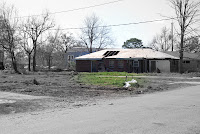But there it lay before us. I try to imagine what it looked like and felt like before. I try to imagine a neighborhood like Marigny – quirky, colorful and loved! Neighbors who’d known each other for hundreds of years, stories begun and ended, struggles won and lost, a history that made this home to so many.
 Now a massive, bleak, empty field. A rare tree or two left, a boarded up brick house (the only houses that survived) every now and then, and row after row after row of bare cement foundations (the only things left) that sit like gigantic cemetery headstones. We criss-cross through uneven, desolate streets.
Now a massive, bleak, empty field. A rare tree or two left, a boarded up brick house (the only houses that survived) every now and then, and row after row after row of bare cement foundations (the only things left) that sit like gigantic cemetery headstones. We criss-cross through uneven, desolate streets. It was unexpected. We all know the stories, we watched the news, we saw the horrific human suffering first at the hands of nature and then in the hands of man. But to stand there and be a witness.
 There’s one brick house standing in the corner, the shingles are completely eradicated, and only a plywood cover remains. In the center a large hole was cut. Tom points to it – that’s not a rescue hole. It was cut by those hiding in the attic to escape the increasing water.
There’s one brick house standing in the corner, the shingles are completely eradicated, and only a plywood cover remains. In the center a large hole was cut. Tom points to it – that’s not a rescue hole. It was cut by those hiding in the attic to escape the increasing water. A book back at home tells of Thomas Coleman, old retired longshoreman, storyteller, friend. At 80 years old, he died in his attic on 2214 St. Roch Avenue, around August 29, 2005. A can of juice and a bedspread with him when the waters rose.
To imagine the suffering of one, to try for a moment to really imagine that feeling of hopelessness, despair, and perhaps bittersweet acceptance – what can you do at that point - alone in the wretching attic darkness of a loved home, your own home, waiting for the end. Feel that suffering multiplied to all those who died, who waited, who wondered…then somehow I’m no longer standing in the 9th ward but looking at the world, spinning, and hear only soft cries of the collective human suffering from Auschwitz to Afghanistan.
And yet, life goes on. The coldest winter turns to spring, crocuses will fearlessly push through the snow to bloom again. The grass of the lower 9th ward grows silently as one-by-one homes are rebuilt and, over time, hope is restored to its rightful place.
 It’s interesting to feel this, right now. To let myself suffer, just for a few moments of my fortunate life, to try to understand what others have experienced in such greater magnitude. Standing in an empty field, where only ghosts hint at what was, the sadness is overwhelming, but I’m glad to be here now and I’m glad to feel this. I'm thinking maybe that it’s that suffering and that hope, and unfolding compassion, that connects us, one to the other.
It’s interesting to feel this, right now. To let myself suffer, just for a few moments of my fortunate life, to try to understand what others have experienced in such greater magnitude. Standing in an empty field, where only ghosts hint at what was, the sadness is overwhelming, but I’m glad to be here now and I’m glad to feel this. I'm thinking maybe that it’s that suffering and that hope, and unfolding compassion, that connects us, one to the other.After we get back to neighborhoods where houses still stand, I notice it more. The faded spray paint on old front doors. The “X” which tells who searched, date of search, and bodies.
Thousands dead, a thousand still missing.


No comments:
Post a Comment